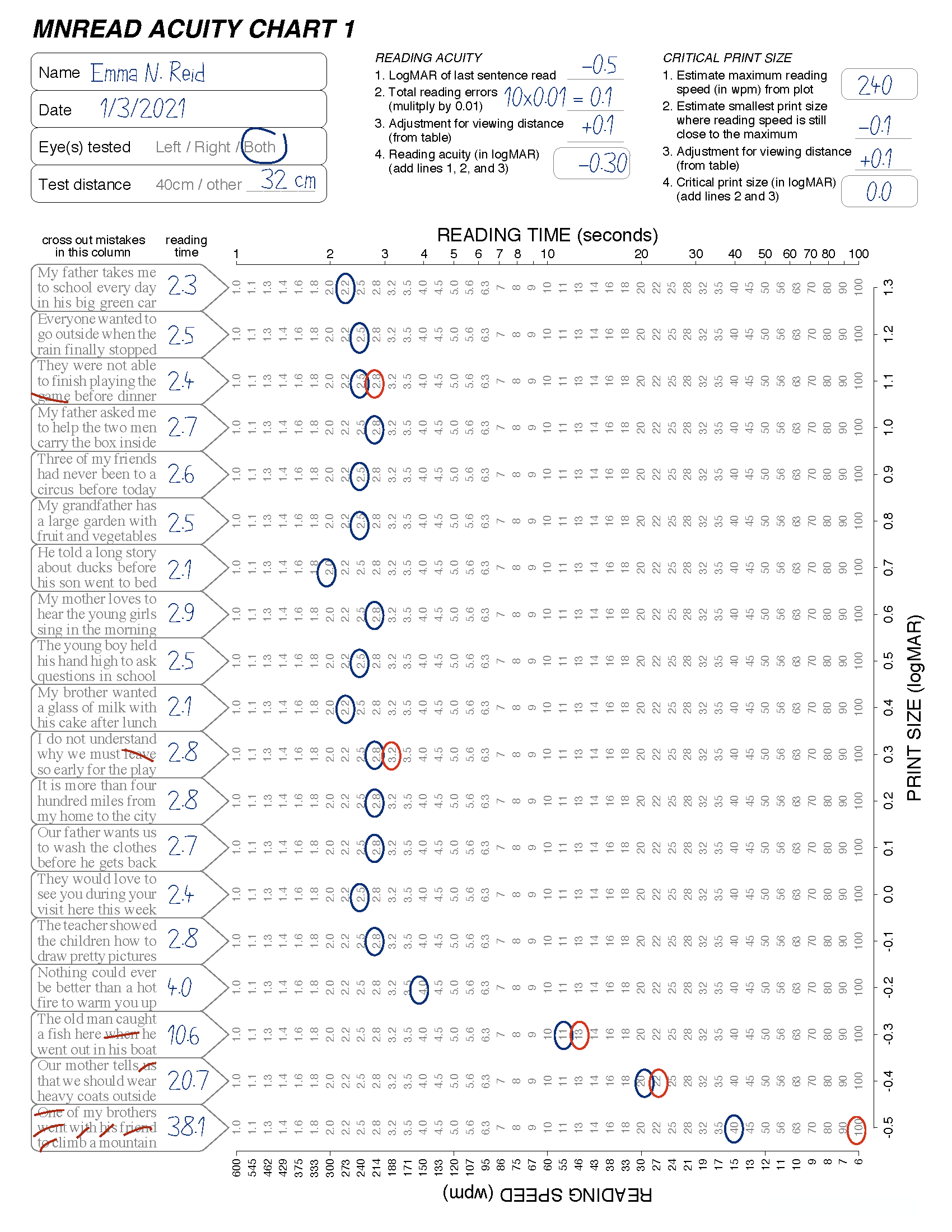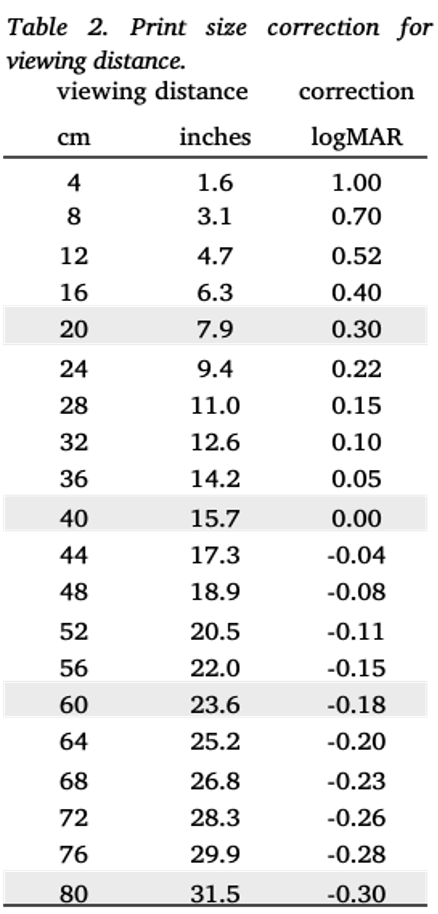Calculation of Reading Acuity
An estimate of reading acuity is given by the smallest print size at which the patient can read the entire sentence without making significant errors. Usually reading performance deteriorates rapidly as the acuity limit is approached, and it is easy to determine the level where reading becomes impossible. This method measures acuity to the nearest 0.1 logMAR.
The MNREAD charts can be used to provide a more sensitive and reliable measure of reading acuity. Each sentence has 60 characters, which corresponds to 10 standard length words, assuming a standard word length of 6 characters (including a space). Thus, each sentence can be divided into 10 smaller parts, and acuity can be measured to the closest 0.01 logMAR.
- After the patient has read as much of the chart as possible, make a note of the print size (in logMAR) of the smallest sentence that the patient read or attempted to read.
- Count the number of reading errors made by the patient (i.e., the number of words that patient skipped over or read incorrectly.
- Calculate reading acuity (in logMAR) using the following formula:
Reading acuity = size of smallest sentence read + 0.01 x number of errors
Scoring for non-standard viewing distances
A convenient feature of the logMAR scale is that it allows simple conversion of reading acuity between different viewing distances. If the chart was used at a reading distance other than 40 cm (16 inches) the reading acuity and critical print size need to be adjusted according to the value given in Table 2.
Example
The patient is tested using a 20cm viewing distance and reads (or attempts to read) all the sentences down to the –0.2 logMAR sentence but makes a total of 12 reading errors.
Acuity = –0.2 logMAR + 12 errors × 0.01 + 0.30 logMAR (distance correction from Table 2) = 0.22 logMAR.
Calculation of reading speed
Reading speed is measured in words per minute (wpm). With the MNREAD acuity charts, the reading speed calculation is simplified because each sentence has the same length: 10 standard length words. Reading speed is given by:
reading speed (wpm) = 600 / (reading time in seconds)
A more precise reading speed measurement can be achieved by excluding words that were missed or read incorrectly. In this case reading speed is given by:
reading speed (wpm) = 60 × (10 – errors) / (reading time in seconds)
If more than 10 reading errors were made, then reading speed can be assumed to be zero.
Determining the critical print size and maximum reading speed
The critical print size is the smallest print size at which patients can read with their maximum reading speed. This is an important measure as it indicates the minimum magnification required for effortless reading.
The critical print size is most easily identified from a plot of the patient's reading speed at each print size (instructions are given below for how to create this plot using the MNREAD datasheet). Typically, reading time remains fairly constant for large print sizes. But as the acuity limit is approached there comes a print size where reading starts to slow down. This is the critical print size. If the chart was used at a reading distance other than 40 cm (16 inches) the critical print size should be adjusted according to the value given in Table 2.
The reading speed with print larger than the critical print size is the patient’s maximum reading speed. This is the reading speed that can be achieved by the patient when print size is not a limiting factor.
Using the datasheet
The data-sheet can be used to quickly create a plot showing how the patient’s reading speed depends on print size.
As the patient reads each sentence, cross out any words on the datasheet that are missed or read incorrectly. When the patient has read the sentence, write the reading time (to the nearest 0.1 sec) in the space to the right of the sentence. This reading time can be plotted on the chart by circling the reading time on the column of times for that print size (circle the value that is closest to the measured time). If the patient made any reading errors, then the reading time should be adjusted so that it reflects the time required to read all the words correctly. This is achieved by stepping to a longer time — the number of steps depends on the number of errors. For 1, 2, 3, or 4 errors move 1, 2, 3 or 4 steps respectively. (The adjustments for 5 or more errors are shown in Table 1). Circle the adjusted reading time. The reading speed (in words per minute) can be read off from the reading-speed column at the left of the data plot.
Examples: The patient reads a sentence in 4.3 seconds making 3 errors. The closest time in the column is 4.5 seconds. Three reading errors requires the time to be adjusted by 3 steps to 6.3 seconds (reading speed = 95 wpm). For a sentence read in 10.5 seconds with 7 errors, the closest time in the column is 11 seconds, which needs to be adjusted by 10 steps to 35 seconds (reading speed = 17 wpm.)
Follow the instructions at the top of the datasheet to calculate reading acuity, maximum reading speed and critical print size. If the chart was used at a reading distance other than 40 cm (16 inches) the reading acuity and critical print size need to be adjusted according to the value given in Table 2.


